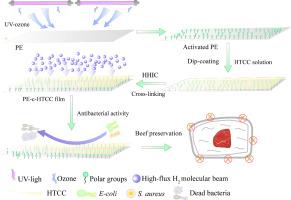Antibacterial activity of polyethylene film by hyperthermal hydrogen induced cross-linking with chitosan quaternary ammonium salt
IF 8.5
1区 化学
Q1 BIOCHEMISTRY & MOLECULAR BIOLOGY
International Journal of Biological Macromolecules
Pub Date : 2025-01-01
DOI:10.1016/j.ijbiomac.2024.138335
引用次数: 0
Abstract
In this study, hyperthermal hydrogen-induced cross-linking (HHIC) technology was applied to construct a dense cross-linking layer of antibacterial chitosan quaternary ammonium salt (HTCC) to PE surface through the selective cleavage of C![]() H bonds and subsequent cross-linking of the resulting carbon radicals. Before HHIC treatment, UV-Ozone was used to activate PE surface to facilitate HTCC adsorption. FT-IR and XPS analyses proved the successful cross-linking between PE and HTCC. From AFM analysis, the prepared PE cross-linked HTCC film (PE-c-HTCC) showed the rougher surface with average roughness (Ra) of 9.16 nm. The water vapor permeability (WVP) and oxygen permeability (OP) values of the film were decreased by about 83 % and 97 %, respectively. Additionally, the film exhibited strong antibacterial properties against E. coli and S. aureus. In terms of these properties, the shelf life of fresh beef could be extended for 2 days after packing with the PE-c-HTCC film.
H bonds and subsequent cross-linking of the resulting carbon radicals. Before HHIC treatment, UV-Ozone was used to activate PE surface to facilitate HTCC adsorption. FT-IR and XPS analyses proved the successful cross-linking between PE and HTCC. From AFM analysis, the prepared PE cross-linked HTCC film (PE-c-HTCC) showed the rougher surface with average roughness (Ra) of 9.16 nm. The water vapor permeability (WVP) and oxygen permeability (OP) values of the film were decreased by about 83 % and 97 %, respectively. Additionally, the film exhibited strong antibacterial properties against E. coli and S. aureus. In terms of these properties, the shelf life of fresh beef could be extended for 2 days after packing with the PE-c-HTCC film.

高温氢诱导壳聚糖季铵盐交联聚乙烯膜的抗菌活性研究。
本研究采用超热氢诱导交联(HHIC)技术,通过选择性裂解CH键,形成碳自由基交联,构建抗菌壳聚糖季铵盐(HTCC)与PE表面的致密交联层。在hic处理前,用uv -臭氧活化PE表面,促进HTCC的吸附。FT-IR和XPS分析证实PE与HTCC交联成功。AFM分析表明,制备的PE交联HTCC膜(PE-c-HTCC)表面较粗糙,平均粗糙度Ra为9.16 nm。膜的水蒸气渗透性(WVP)和氧气渗透性(OP)分别降低了约83 %和97 %。此外,该膜对大肠杆菌和金黄色葡萄球菌具有较强的抗菌性能。根据这些特性,用PE-c-HTCC薄膜包装后,新鲜牛肉的保质期可延长2 天。
本文章由计算机程序翻译,如有差异,请以英文原文为准。
求助全文
约1分钟内获得全文
求助全文
来源期刊
CiteScore
13.70
自引率
9.80%
发文量
2728
审稿时长
64 days
期刊介绍:
The International Journal of Biological Macromolecules is a well-established international journal dedicated to research on the chemical and biological aspects of natural macromolecules. Focusing on proteins, macromolecular carbohydrates, glycoproteins, proteoglycans, lignins, biological poly-acids, and nucleic acids, the journal presents the latest findings in molecular structure, properties, biological activities, interactions, modifications, and functional properties. Papers must offer new and novel insights, encompassing related model systems, structural conformational studies, theoretical developments, and analytical techniques. Each paper is required to primarily focus on at least one named biological macromolecule, reflected in the title, abstract, and text.

 求助内容:
求助内容: 应助结果提醒方式:
应助结果提醒方式:


